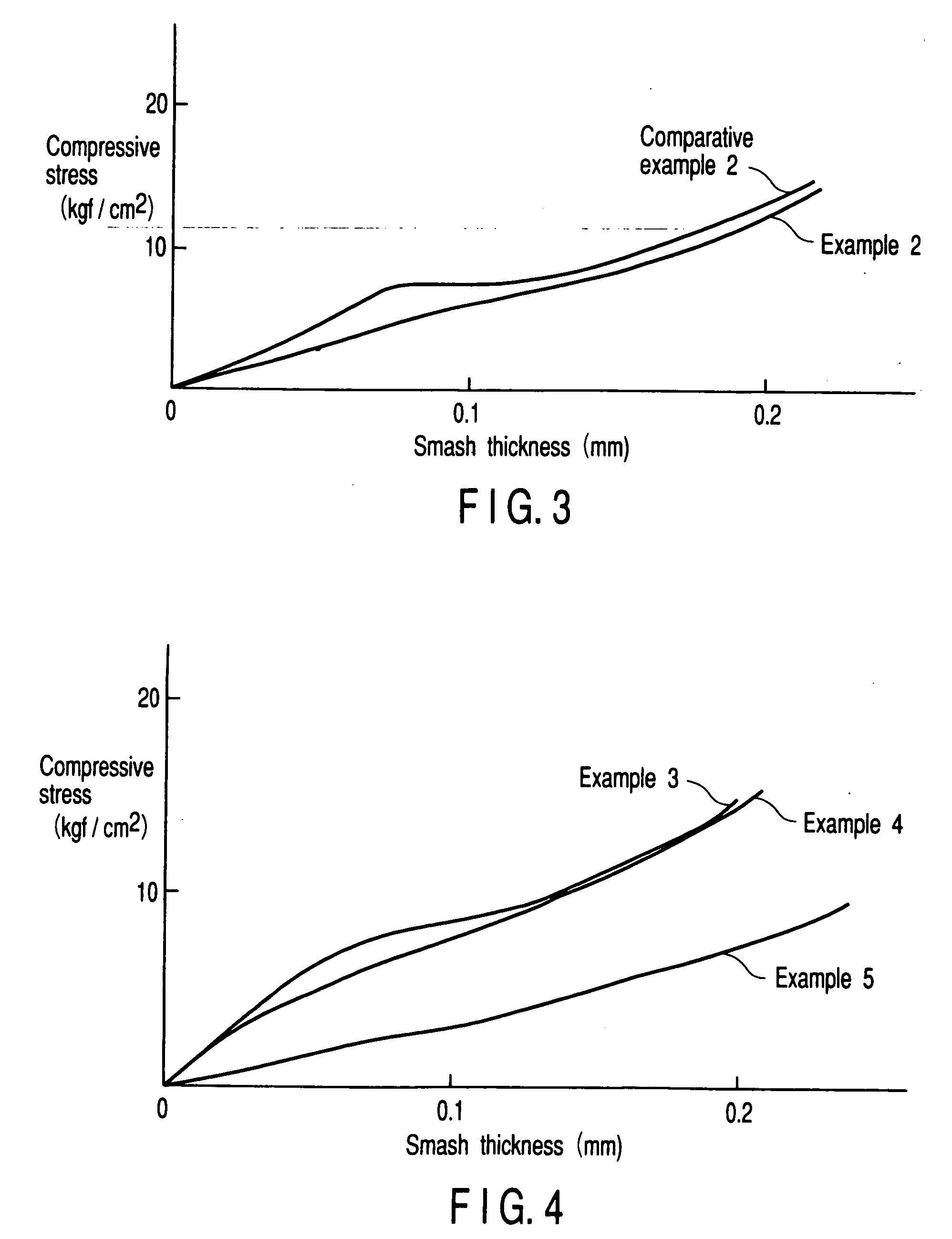Compressible printing blanket and method of manufacturing a compressible printing blanket
a printing blanket and compressible technology, applied in the field of compressible printing blankets and compressible printing blankets, can solve the problems of particular methods not desirable in view of environmental damage, troublesome methods, blurred printed surfaces,
- Summary
- Abstract
- Description
- Claims
- Application Information
AI Technical Summary
Benefits of technology
Problems solved by technology
Method used
Image
Examples
example 1
[0104] Sulfur, a vulcanization accelerator M (2-mercaptobenzothiazole), an aging preventive, a reinforcing agent and a plasticizer were added to 100 parts by weight of a medium high acrylonitrile-butadiene rubber (NBR), and the resultant mixture was dissolved in methyl ethyl ketone so as to prepare a rubber paste A.
[0105] Rubber paste B was obtained by adding 14 parts by weight of Exbancell 092DE (trade name of microballoons formed of a copolymer between methacrylonitrile and acrylonitrile manufactured by Novel Industries Inc.) and 8 parts by weight of diethylene glycol used as a melting agent to rubber paste A described above. Incidentally, the average particle diameter of the microballoons was 80 μm.
[0106] Prepared as the fabric layers were three cotton cloths each having a thickness of about 0.4 mm. Then, one surface of the cotton cloth 2a forming the upper fabric cloth layer was coated with the rubber paste B in a thickness of 0.3 mm so as to obtain an unvulcanized compressibl...
example 2
[0111] Rubber paste C was obtained by adding 3 parts by weight of microballoons substantially equal to those referred to in Example 1 to the rubber paste A of the composition similar to that referred to in Example 1.
[0112] Prepared as the rubber paste for the compressible layer was the rubber paste B equal to that referred to in Example 1.
[0113] An unvulcanized compressible rubber blanket having a thickness of about 2.1 mm was prepared as in Example 1, except that used was the rubber paste C in the unvulcanized adhesive layer.
[0114] After the unvulcanized compressible rubber blanket was wound around a metal drum, the unvulcanized compressible rubber blanket was heated at 150° C. for 6 hours in a vulcanizing can so as to finish the vulcanization.
[0115] Further, the vulcanized compressible rubber blanket was cooled, followed by polishing the surface rubber layer with a sand paper of 240 mesh so as to obtain a compressible blanket constructed as shown in FIG. 1 and having a thickne...
example 6
[0132] Prepared as the rubber paste for the adhesive layer was rubber paste A equal in composition to the rubber paste A referred to in Example 1. Also prepared as the rubber paste for the compressible layer was rubber paste B equal in composition to rubber paste B referred to in Example 1.
[0133] Prepared as the fabric layers were three cotton cloths each having a thickness of about 0.4 mm. One surface of the cotton cloth 2a constituting the upper fabric layer was coated with the rubber paste B in a thickness of 0.3 mm, followed by pasting a cotton cloth 4 used as a reinforcing layer and having a thickness of about 0.4 mm to the coated rubber paste B (unvulcanized compressible layer).
[0134] After the unvulcanized compressible layer thus obtained was wound around a metal drum, heating was applied to the unvulcanized compressible layer at 150° C. for 6 hours within a vulcanizing can so as to finish the vulcanization.
[0135] After an unvulcanized adhesive layer 3a was formed by coati...
PUM
| Property | Measurement | Unit |
|---|---|---|
| Thickness | aaaaa | aaaaa |
| Thickness | aaaaa | aaaaa |
| Thickness | aaaaa | aaaaa |
Abstract
Description
Claims
Application Information
 Login to View More
Login to View More - R&D
- Intellectual Property
- Life Sciences
- Materials
- Tech Scout
- Unparalleled Data Quality
- Higher Quality Content
- 60% Fewer Hallucinations
Browse by: Latest US Patents, China's latest patents, Technical Efficacy Thesaurus, Application Domain, Technology Topic, Popular Technical Reports.
© 2025 PatSnap. All rights reserved.Legal|Privacy policy|Modern Slavery Act Transparency Statement|Sitemap|About US| Contact US: help@patsnap.com



